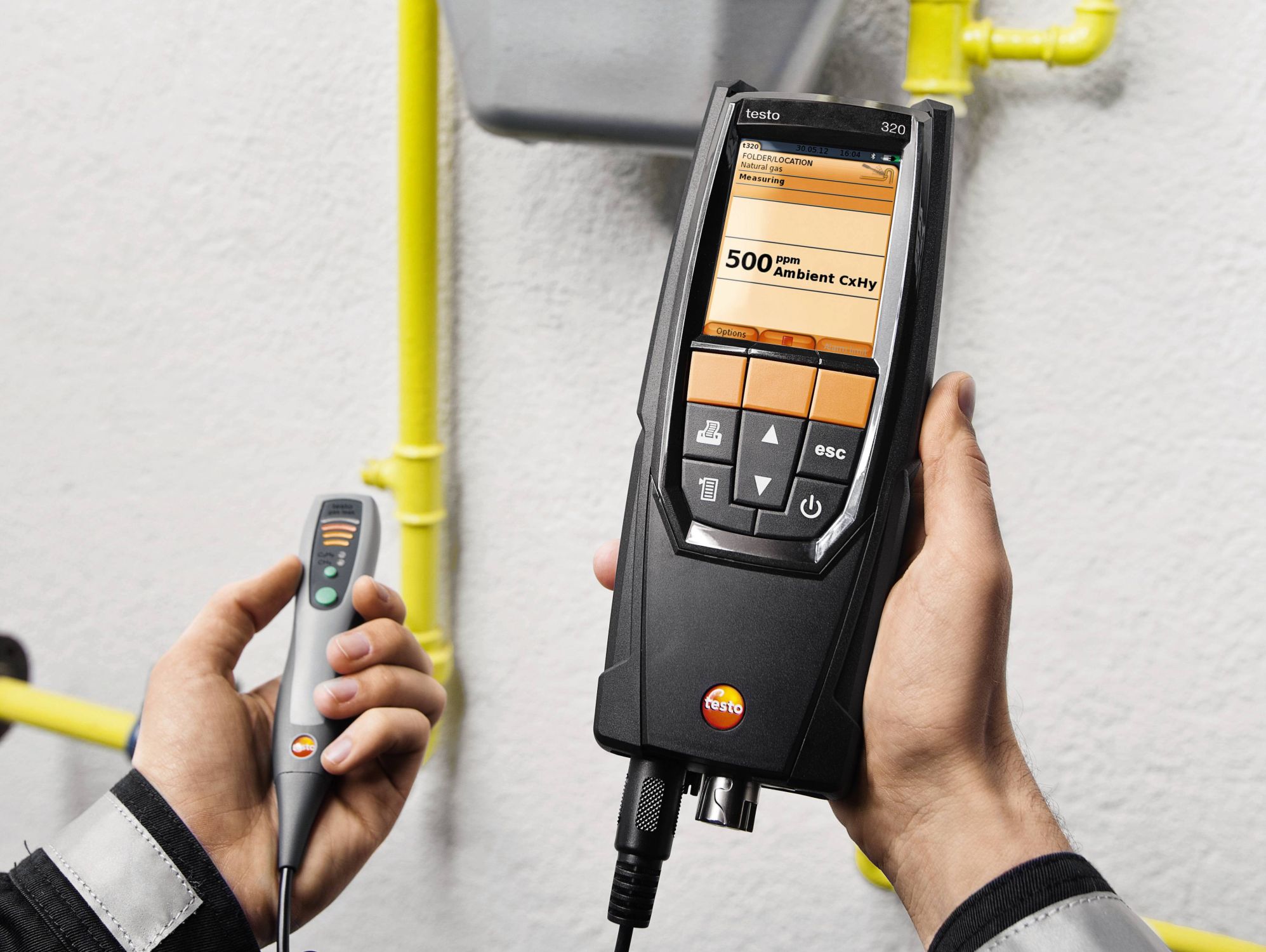- Home
- testo 320
testo 320
0563 3220 76- TÜV-tested according to EN 50379, Parts 1-3.
Applications:
- Flue gas measurement
- Draught measurement
- Gas flow and static gas pressure
- Gas leak detection
- Ambient CO measurement
- Differential temperature measurement
General technical data
| Weight | 573 g |
|---|---|
| Dimensions | 240 x 85 x 65 mm |
| Operating temperature | -5 to +45 °C |
| Display size | 240 x 320 pixels |
| Display function | Colour graphic display |
| Power supply | Battery: 3.7 V / 2,400 mAh; Mains unit: 6 V / 1.2 A |
| Maximum memory | 500 Measurement values |
| Storage temperature | -20 to +50 °C |
Differential Pressure - Piezoresistive
| Measuring range | ±10000 Pa |
|---|---|
| Accuracy | ±3 % of mv (10 to 10000 Pa) plus ±1 Digit ±0.3 Pa (0 to 9.99 Pa) plus ±1 Digit |
Flue gas CO (with H₂-compensation)
| Measuring range | 0 to 8000 ppm |
|---|---|
| Accuracy | ±10 ppm or ±10 % of mv (0 to 200 ppm) ±10 % of mv (2001 to 8000 ppm) ±20 ppm or ±5 % of mv (201 to 2000 ppm) |
| Resolution | 1 {#0} ppm |
| Reaction time t₉₀ | < 40 s |
Ambient CO measurement in the heated environment
Carbon monoxide (CO) is a colourless, odourless and taste-free gas, but also poisonous. It is produced during the incomplete combustion of substances containing carbon (oil, gas, and solid fuels, etc.). If CO manages to get into the bloodstream through the lungs, it combines with haemoglobin thus preventing oxygen from being transported in the blood; this in turn will result in death through suffocation. This is why it is necessary to regularly check CO emissions at the combustion points of heating systems and the surroundings.

Measuring the flue gas parameters of the burner (CO, O2, and temperature, etc.)
The flue gas measurement for a heating system helps to establish the pollutants released with the flue gas (e.g. carbon monoxide CO or carbon dioxide CO2) and the heating energy lost with the warm flue gas. In some countries, flue gas measurement is a legal requirement. It primarily has two objectives:
- Ensuring the atmosphere is contaminated as little as possible by pollutants; and
- energy is used as efficiently as possible.
Stipulated pollutant quantities per flue gas volume and energy losses must never be exceeded. Measurement in terms of results required by law takes place during standard operation (every performance primarily using the appliance). Using a Lambda probe (single hole or multi-hole probe), the measurement is taken at the centre of flow in the connecting pipe (in the centre of the pipe cross-section, not at the edge) between the boiler and chimney/flue. The measured values are recorded by the flue gas analyzer and can be logged either for print out or transfer to a PC at a later stage.
Measurement is taken by the installer at commissioning, and if necessary four weeks later by the flue gas inspector/chimney sweep, and then at regular intervals by the authorised service engineer.
f

- Instruction manual EasyHeat software(pdf, 3.55 MB)
- Testo ZIV driver ZIV 2000 for testo 320 and testo 330(v2.1, 2.22 MB)Testo ZIV driver in the 2000 version. The Testo ZIV driver is used to connect the testo 320 and testo 330 measuring instruments to an application program (sweeping district administration program) according to the interface Version 2.0 defined by the Zentralverband des Schornsteinfegerhandwerks (Central Association of Chimney Sweeps, ZIV). Please check with the manufacturer of your application program as to whether this interface is supported. If Microsoft .NET Framework 4.0 has not been installed on the computer, it must be downloaded from the Microsoft website and installed on the system.
- Testo ZIV driver for testo 300, testo 320 and testo 330(v2.3, 64.11 MB)The Testo ZIV driver is used to connect the testo 300, testo 320 and testo 330 measuring instruments to an application program (sweeping district administration program) according to the interface defined by the Zentralverband des Schornsteinfegerhandwerks (ZIV, Central Association of Chimney Sweeps) in version 1.0 of 01. August 2012, in version 2.0 of 13. February 2017 as well as version 3.0 from 02. July 2021. Please check with the manufacturer of your application program as to whether this interface is supported.
